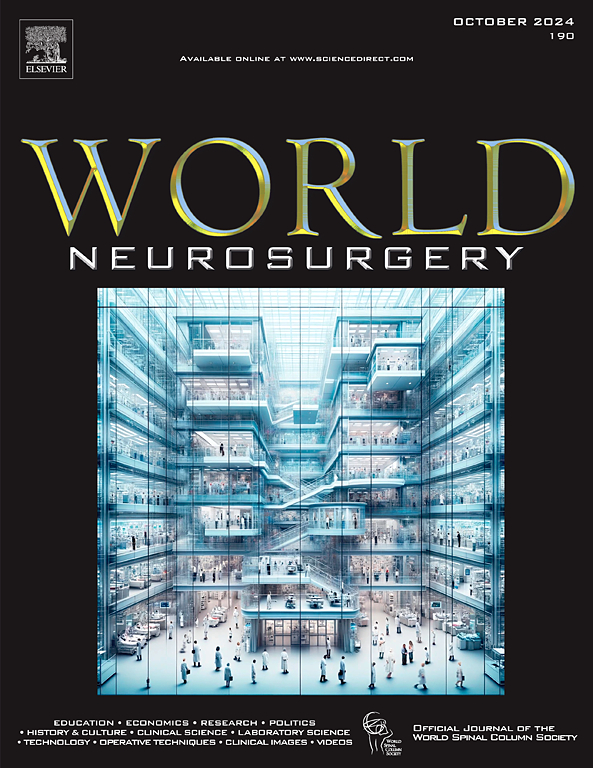Comparative Analysis of the Health-Related Quality of Life Between Patients with Familial and Sporadic Forms of Cerebral Cavernous Malformation
IF 1.9
4区 医学
Q3 CLINICAL NEUROLOGY
引用次数: 0
Abstract
Objective
To compare health-related quality of life (HRQoL) in patients with familial form of cerebral cavernous malformation (fCCM) versus those with sporadic form of cerebral cavernous malformation (sCCM).
Methods
A cross-sectional observational study was conducted involving adult patients receiving outpatient care at a specialized referral center for cerebral cavernous malformation (CCM). In addition to clinic visits, demographic data and imaging were reviewed. Patients completed the Patient-Reported Outcome Measurements Information System, version 2.0 (PROMIS-29), and the EuroQol 5 dimensions 5 levels, version 3.1. Data were compared using a 2-tailed 2-sample t-test or Mann-Whitney test for continuous variables. Pearson χ2 or Fisher's exact test assessed the association between 2 categorical variables.
Results
Eighty-three patients participated in the study over one year. The average age of the participants was 45.37 years (standard deviation = 14.75), with 53 (63.86%) being female. On average, patients had 12.48 years of education (standard deviation = 3.87), and 36 (43.37%) had the familial form of the disease. No significant differences in HRQoL were observed between patients with familial fCCM and sCCM. Among symptomatic patients, there were also no differences between the 2 groups in any domain of either assessment tool. However, within the fCCM group, symptomatic individuals reported worse HRQoL in the usual activities domain of the EuroQol 5 dimensions 5 levels (P = 0.014) and the physical function domain of the PROMIS-29 (P = 0.031) when compared to asymptomatic individuals.
Conclusions
This study found no significant differences in HRQoL between patients with fCCM and sCCM.
家族性与散发性脑海绵状血管瘤患者健康相关生活质量的比较分析
目的:比较家族性海绵状血管瘤(fCCM)与散发性海绵状血管瘤(sCCM)患者的健康相关生活质量(HRQoL)。方法:一项横断面观察性研究,涉及在脑海绵状血管瘤(CCM)专科转诊中心接受门诊治疗的成年患者。除了诊所访问,人口统计数据和影像学检查进行了审查。患者完成患者报告结果测量信息系统2.0版(promise -29)和欧洲生活质量5D-5L 3.1版(EQ-5D-5L)。数据比较采用双尾双样本t检验或连续变量的Mann-Whitney检验。皮尔逊卡方检验(χ2)或费雪精确检验评估两个分类变量之间的相关性。结果:83例患者在一年多的时间里参与了研究。参与者的平均年龄为45.37岁(SD = 14,75),其中女性53人(63.86%)。患者平均受教育年龄为12.48年(SD = 3,87),家族性疾病36例(43.37%)。家族性fCCM与sCCM患者的HRQoL无显著差异。在有症状的患者中,两组在任何评估工具的任何领域也没有差异。然而,在fCCM组中,与无症状个体相比,有症状个体在EQ-5D-5L的常规活动域(p = 0.014)和promisl -29的物理功能域(p = 0.031)报告的HRQoL更差。结论:本研究发现fCCM和sCCM患者的HRQoL无显著差异。
本文章由计算机程序翻译,如有差异,请以英文原文为准。
求助全文
约1分钟内获得全文
求助全文
来源期刊

World neurosurgery
CLINICAL NEUROLOGY-SURGERY
CiteScore
3.90
自引率
15.00%
发文量
1765
审稿时长
47 days
期刊介绍:
World Neurosurgery has an open access mirror journal World Neurosurgery: X, sharing the same aims and scope, editorial team, submission system and rigorous peer review.
The journal''s mission is to:
-To provide a first-class international forum and a 2-way conduit for dialogue that is relevant to neurosurgeons and providers who care for neurosurgery patients. The categories of the exchanged information include clinical and basic science, as well as global information that provide social, political, educational, economic, cultural or societal insights and knowledge that are of significance and relevance to worldwide neurosurgery patient care.
-To act as a primary intellectual catalyst for the stimulation of creativity, the creation of new knowledge, and the enhancement of quality neurosurgical care worldwide.
-To provide a forum for communication that enriches the lives of all neurosurgeons and their colleagues; and, in so doing, enriches the lives of their patients.
Topics to be addressed in World Neurosurgery include: EDUCATION, ECONOMICS, RESEARCH, POLITICS, HISTORY, CULTURE, CLINICAL SCIENCE, LABORATORY SCIENCE, TECHNOLOGY, OPERATIVE TECHNIQUES, CLINICAL IMAGES, VIDEOS
 求助内容:
求助内容: 应助结果提醒方式:
应助结果提醒方式:


